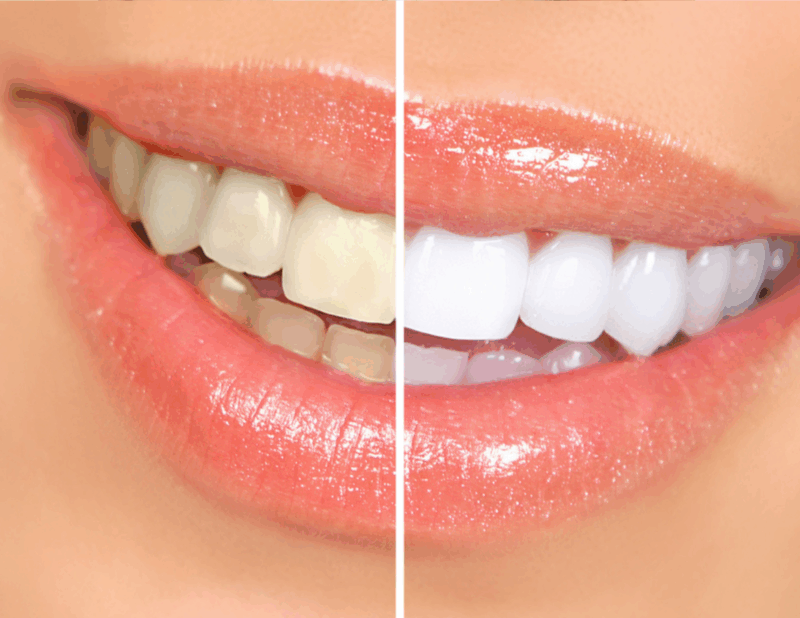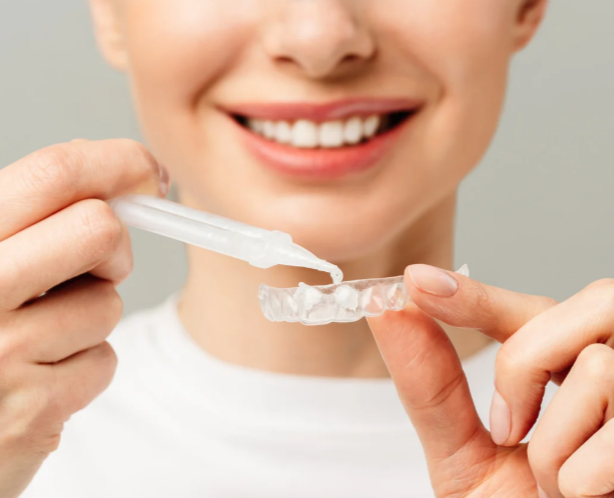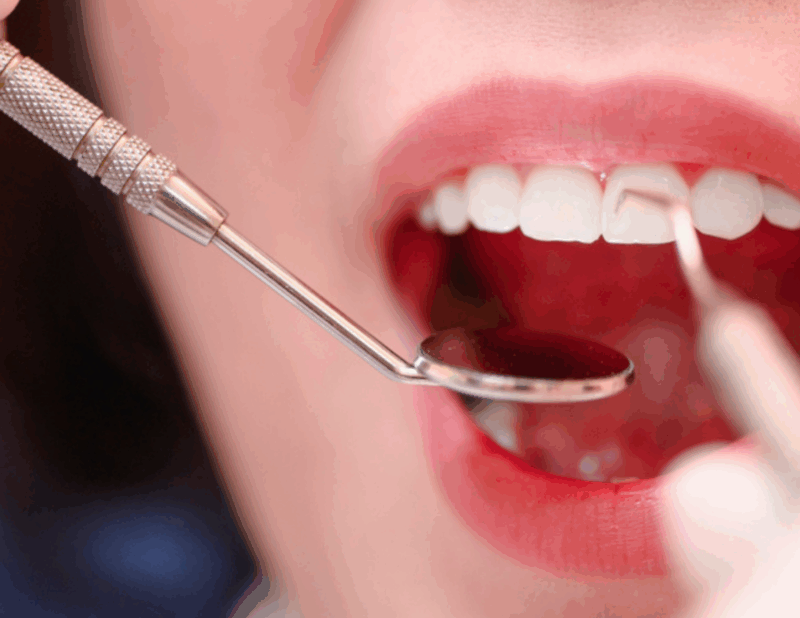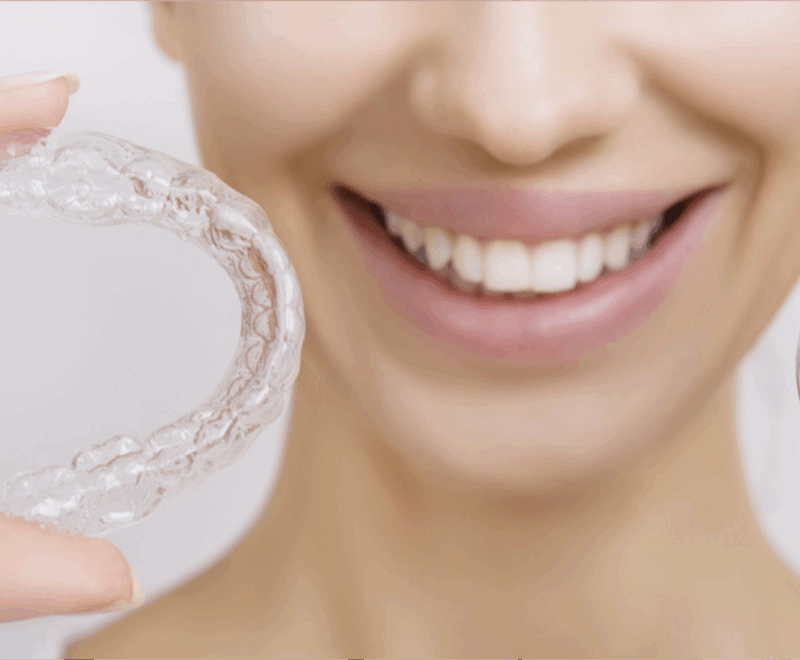Dental Services
Teeth Whitening

Teeth whitening is a cosmetic procedure that helps remove stains and discoloration, making teeth appear whiter and brighter.
It works by using bleaching agents, such as hydrogen peroxide or carbamide peroxide, which break down stains on the enamel.
Types of Stains:
- Intrinsic stains
- Inside the enamel, caused by aging, medications, or excessive fluoride consumption (typically while under 8 -12 years old).
- Extrinsic stains
- On the surface of teeth, caused by coffee, tea, smoking, and tooth staining foods.

Whitening Methods:
- Professional Whitening
- Done in the dental office using stronger bleaching agents.
- At-Home Whitening:
- Done using a whitening kit provided by your dental provider to whiten teeth in the comfort of your own home


Routine Oral Care
Routine oral care involves a comprehensive dental check-up and professional cleaning to maintain oral health and catch any potential problems early.
The Dental Examination includes an exam on teeth, gums, tongue, and mouth for signs of: Cavities, Gum disease, Oral cancer, Bite or alignment issues. X-rays are also taken at the dental exam to detect problems not visible to the naked eye, such as decay between teeth, bone loss, or impacted teeth.
- Professional Cleaning (Prophylaxis)
- Plaque and Tartar Removal: Special tools (like scalers) are used to remove plaque and hardened tartar from above and below the gumline.
- Polishing: Teeth are polished with a gritty toothpaste to remove surface stains and smooth the enamel


Dental Emergencies
Dental emergencies are urgent oral health issues that require immediate attention to relieve pain, stop bleeding, or save a tooth. Common dental emergencies include:
- Toothache
- Knocked-Out Tooth (Avulsed Tooth)
- Chipped or Broken Tooth
- Dental Abscess
- Lost or Damaged Fillings/Crowns
- Bleeding or Injured Gums/Tissues


Invisilign
- A modern and popular alternative to braces
- Invisalign is an Orthodontic treatment that uses clear, custom-made, removable aligners to straighten teeth over time and create a beautiful smile
- These aligners are virtually invisible and are removable, unlike traditional braces
- Invisalign is available for both teenagers and adults and is suitable for treating a variety of dental issues including crowding, spacing, overbites, and crossbites
- Invisalign requires less in person appointments and patients can easily switch to their next set of aligners in the order of the treatment your dentist has laid out for you
- Customized treatment: Each aligner is tailored specifically to the patient’s teeth for precise, effective results.

Restorations / Dental Fillings
- Restorations repair damaged teeth using various material such as composite
- Dental restorations are procedures that repair or replace parts of a tooth (or multiple teeth) that have been damaged by decay, trauma, or wear. The goal is to restore the function, shape, appearance, and strength of teeth.
- Dental fillings restore chewing and speaking ability, maintain facial structure, prevent further tooth damage or loss, and improve appearance and confidence


Composite Bonding
- Dental composite bonding is a cosmetic dental procedure where a tooth-colored resin material (composite) is applied to the surface of a tooth to improve its appearance or restore it.
- Composite bonding can repair chipped or cracked teeth, improve the appearance of discolored teeth, close small gaps between teeth, make teeth look longer, or reshape teeth

Cosmetic Dentistry
- Focuses on improving the appearance of patients’ teeth and smiles
- It involves various procedures aimed at enhancing aesthetics
While traditional dentistry focuses on oral health and treating dental problems (like cavities or gum disease), cosmetic dentistry is mainly about enhancing aesthetics — making your smile look better.

Crowns
- Crowns are a tooth shaped “cap” or covering that is placed over a damaged or weakened tooth to restore its shape, size, strength and appearance
- Crowns are commonly used when a tooth is too damaged for a filling or after procedures like root canals. They can be made from various materials, including porcelain, ceramic, metal, or a combination, depending on the location and function of the tooth.
- The crown fully encases the visible portion of the tooth above the gumline, protecting it and improving its functionality. Crowns are carefully color-matched to blend naturally with surrounding teeth, providing both aesthetic and functional benefits.

Bridge
- A bridge replaces one or more missing teeth using a false tooth to fill the gap. It “bridges” the gap between two teeth and the false tooth is supported by crowns on the teeth in front of and behind the gap
- A bridge restores function and helps to chew and speak normally.
- A bridge improves aesthetics by filling in gaps to restore your smile.

Endodontics / Root Canals
- Damaged or infected nerve tissue is removed from inside of a tooth and the inside of the tooth is cleaned, filled, and sealed to prevent future infection

Oral Surgery / Extractions
- Infected or severely damaged teeth are removed when there is not enough tooth structure left to repair the tooth

